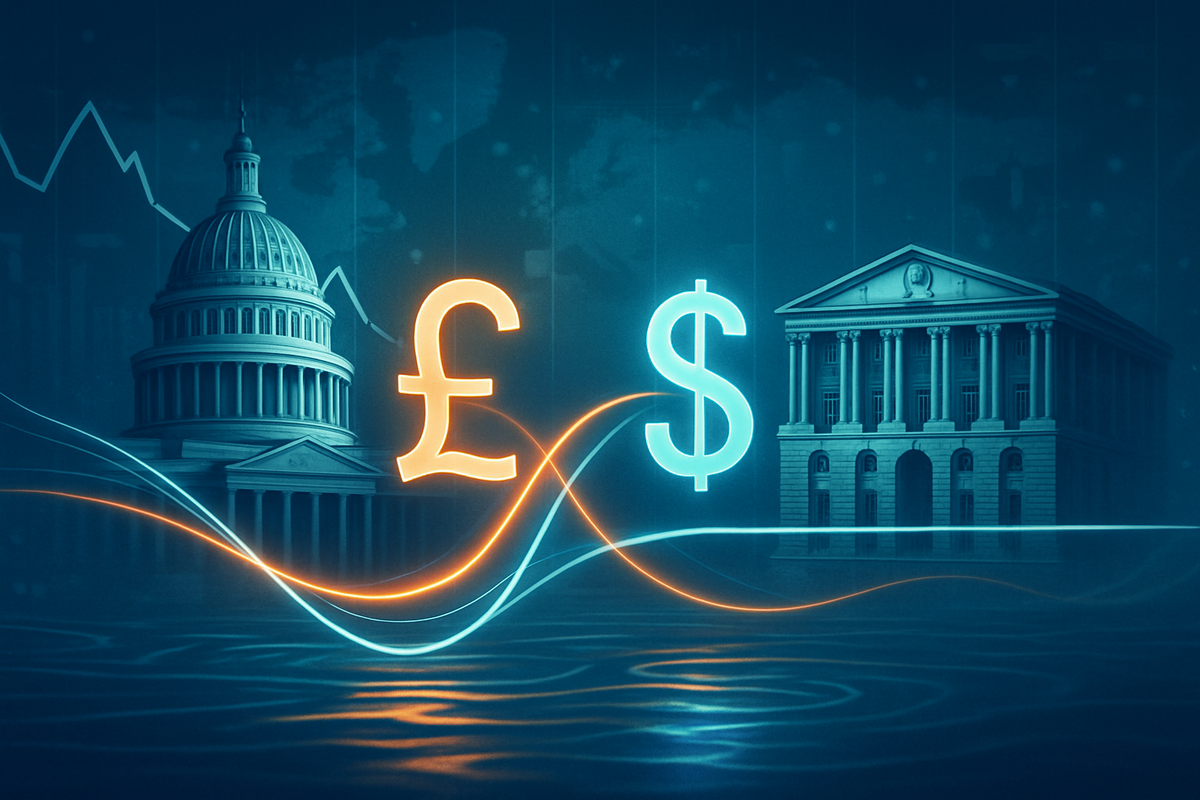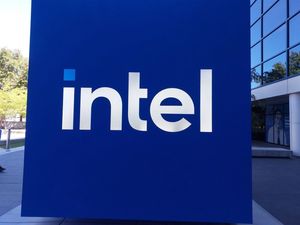
As the Federal Reserve signals an aggressive path of interest rate cuts, driven by concerns over a softening U.S. economy, the British Pound to US Dollar (GBP/USD) exchange rate finds itself at a critical juncture. With the Bank of England (BoE) adopting a more measured approach to monetary policy, the divergence between the two central banks is creating significant ripples in global currency markets. This dynamic is setting the stage for potential volatility and strategic re-evaluations for investors and multinational corporations alike.
The immediate implications are palpable: while the U.S. Dollar (USD) has shown unexpected resilience on October 6, 2025, largely due to safe-haven flows amidst a U.S. government shutdown, the underlying sentiment points to a cautious outlook for Sterling. The Fed's anticipated easing cycle, which began with a 25 basis point cut in September 2025, is expected to continue with further reductions in October and December. This stark contrast to the Bank of England's current holding pattern, despite earlier cuts in 2025, is the primary driver influencing the GBP/USD pair, pushing it towards technical downtrends and raising downside risks for the Pound.
The Mechanics of Influence: How Fed Policy Reshapes GBP/USD
The intricate dance between central bank policies and currency valuations is on full display as the Federal Reserve's actions continue to dictate the trajectory of the British Pound to US Dollar (GBP/USD) exchange rate. The Fed wields its influence through several key mechanisms, primarily impacting interest rate differentials, employing quantitative easing (QE) or tightening (QT), providing forward guidance, shaping global risk sentiment, and managing inflation expectations.
At its core, interest rate differentials are a fundamental driver. When the Fed signals or implements rate cuts, it generally diminishes the attractiveness of USD-denominated assets compared to those in the UK, where the Bank of England (BoE) is currently holding rates steady. This divergence can lead to capital outflow from the U.S. and into the UK, strengthening the Pound against the Dollar. Conversely, a hawkish Fed stance would typically bolster the USD. Beyond direct rates, the Fed's balance sheet policies, such as QE (which injects liquidity and typically weakens the USD) or QT (which withdraws liquidity and strengthens the USD), also play a crucial role. Furthermore, the Fed's forward guidance—its communication about future policy intentions—is meticulously scrutinized by traders, acting as a compass for market expectations and reducing volatility. Finally, the dollar's role as a global safe-haven asset means that Fed policies impacting risk sentiment can trigger significant capital shifts, while its ability to manage inflation expectations directly affects the dollar's purchasing power.
The path to October 6, 2025, has been marked by a series of pivotal events. Throughout 2024, global economies grappled with inflation, leading to widespread monetary tightening. The GBP/USD saw significant fluctuations, with a high of 1.3434 in September and a low of 1.23 in April 2024. The narrative shifted dramatically in 2025, with the Bank of England initiating its easing cycle in March, followed by further cuts in June and August, bringing its benchmark rate to 4%. This aggressive easing by the BoE was initially met with a rally in GBP/USD during the first half of 2025, reaching a high of 1.3743 in July, largely fueled by a broader USD sell-off. However, the tide began to turn in September 2025 when the Federal Reserve, in a move largely anticipated by markets, delivered its first rate cut of the year, bringing the federal funds rate to 4.00%-4.25%. This "risk management" cut was driven by concerns over a weakening U.S. labor market, despite persistent inflation. Simultaneously, the Bank of England paused its cutting cycle in September, holding rates at 4% due to sticky UK inflation (CPI at 3.6% in August) and robust wage growth.
Key players in this dynamic include the Federal Reserve (Fed), led by Chair Jerome Powell, with notable voices like Vice Chair Philip Jefferson and Governor Adriana Kugler leaning dovish, while Dallas Fed President Lorie Logan has expressed hawkish concerns about inflation. Their collective decisions through the Federal Open Market Committee (FOMC) are paramount. Across the Atlantic, the Bank of England (BoE), under Governor Andrew Bailey, steers the UK's monetary policy via its Monetary Policy Committee (MPC). These central banks' policy divergences are the core of the GBP/USD's current movements. Beyond official bodies, major financial institutions like (J.P. Morgan Global Research) and (Bloomberg Economics) play a critical role through their forecasts and trading activities, alongside myriad currency traders who interpret every statement and data point. The ongoing U.S. government shutdown in early October 2025 has further complicated matters, delaying crucial economic data and adding an element of uncertainty that has, paradoxically, lent some safe-haven support to the U.S. Dollar, even as aggressive Fed rate cuts are priced in.
Initial market reactions have been nuanced. While a dovish Fed typically weakens the dollar, the USD showed unexpected strength on October 6, 2025, partly due to safe-haven demand amidst the government shutdown and weakness in other major currencies like the Euro and Japanese Yen. This highlights the "Fed Information Effect," where rate cuts in a data-constrained environment might be seen as precautionary rather than confirming deep economic distress, leading to a "liquidity premium effect." Currency traders are keenly watching for upcoming Federal Reserve speeches and FOMC minutes for further clues. The GBP/USD pair has edged lower, trading around 1.3480-1.3500, having broken its recent uptrend and showing signs of consolidation, with analysts anticipating a muted range in the near term, but with risks leaning to the downside for Sterling.
Corporate Fortunes in Flux: Navigating the Fed's Rate Path
The Federal Reserve's anticipated trajectory of interest rate adjustments and the subsequent gyrations of the British Pound to US Dollar (GBP/USD) exchange rate are creating a complex landscape of winners and losers across various sectors and public companies. The impact is multifaceted, channeled through borrowing costs, international trade competitiveness, and the translation of foreign earnings.
In an environment of expected lower Federal Reserve interest rates, which typically leads to a weaker U.S. Dollar (implying a stronger GBP/USD), U.S. exporters stand to gain significantly. Their products become more affordable for international buyers, potentially boosting sales volumes and market share. Multinational corporations with substantial overseas operations, such as consumer staples giant Procter & Gamble (NYSE: PG) and fast-food behemoth McDonald's (NYSE: MCD), would see their foreign earnings translate into a greater number of U.S. dollars, directly enhancing their reported revenues and profits. Furthermore, sectors like real estate and capital-intensive industries, which rely heavily on debt financing, would benefit from reduced borrowing costs, making expansion and new projects more economically viable. Even growth-oriented technology companies, often dependent on accessible capital for innovation, could find a more favorable financial environment.
Conversely, a sustained period of lower U.S. interest rates and a weaker dollar could pose challenges for U.S. importers. While a stronger dollar generally makes imports cheaper, a weakening dollar would increase the cost of goods purchased from abroad, potentially squeezing profit margins for retailers and distributors that source heavily internationally, such as Home Depot (NYSE: HD). Domestically focused financial institutions, including major banks like JPMorgan Chase (NYSE: JPM) and Bank of America (NYSE: BAC), might experience pressure on their net interest margins as the spread between what they earn on loans and pay on deposits narrows in a lower-rate environment. Insurance companies like Travelers Companies (NYSE: TRV), which rely on investment income, could also see reduced returns on their fixed-income portfolios.
However, the immediate term presents a nuanced picture. Despite expectations for further Fed rate cuts, the U.S. Dollar has shown unexpected strength on October 6, 2025, largely due to its safe-haven appeal amidst a U.S. government shutdown and weakness in other major currencies. In this scenario of a temporarily stronger dollar, U.S. importers like Home Depot (NYSE: HD) could see their purchasing power increase, making foreign goods cheaper. Domestically focused companies with minimal international exposure, such as defense contractors like Lockheed Martin (NYSE: LMT) or utility providers, would be relatively insulated from currency fluctuations. On the flip side, a stronger dollar would continue to be a headwind for U.S. exporters and multinational corporations with significant foreign revenue. Tech giants like Apple (NASDAQ: AAPL) and IBM (NYSE: IBM), and apparel companies such as Nike (NYSE: NKE), have historically cited dollar strength as a drag on their international sales and earnings when converted back to USD. Similarly, automotive manufacturers like Ford (NYSE: F), with extensive global supply chains and sales, could face adverse currency translation effects and reduced competitiveness. This dynamic also makes travel to the U.S. more expensive for foreign tourists, potentially impacting luxury retailers like Tiffany & Co. (NYSE: TIF) and department stores such as Macy's (NYSE: M) in tourist-heavy markets.
Ultimately, a company's exposure to these shifts depends on its unique business model, the geographic distribution of its revenues and costs, and its reliance on debt. Those with diversified international operations and robust hedging strategies may be better positioned to navigate the volatility, while those with concentrated exposures could experience more pronounced impacts on their bottom line.
Broader Horizons: The Far-Reaching Implications of Fed Policy
The Federal Reserve's current pivot towards an easing cycle, characterized by anticipated interest rate cuts, extends its influence far beyond the immediate fluctuations of the GBP/USD pair, weaving into broader industry trends, creating ripple effects for global partners, and prompting significant regulatory considerations. This strategic shift by the world's most powerful central bank reverberates throughout the interconnected global financial system.
This move by the Fed fits into a broader trend of central banks navigating complex economic landscapes, balancing inflation control with economic growth. As the U.S. Dollar (USD) remains the world's dominant reserve currency, accounting for a substantial portion of global reserves, any shift in its valuation due to Fed policy triggers a chain reaction. Lower U.S. interest rates typically encourage capital outflows from the U.S. as investors seek higher yields elsewhere, potentially boosting liquidity and investment in emerging markets and other developed economies. This dynamic can lead to periods of monetary policy divergence or convergence, as other central banks, such as the European Central Bank (ECB), may feel compelled to adjust their own rates to manage currency strength and protect their export competitiveness. Furthermore, a weaker dollar, often a consequence of Fed easing, tends to make dollar-denominated commodities like crude oil and gold more affordable for international buyers, potentially supporting their prices.
The ripple effects are profound for global competitors and partners. Other central banks, particularly those in developed economies, closely monitor Fed actions to inform their own monetary policy decisions, aiming to prevent undue currency appreciation that could harm their export sectors. Emerging Markets (EMs) are particularly vulnerable; while Fed tightening can lead to capital outflows and increased costs for dollar-denominated debt, an easing cycle can offer significant relief, potentially fostering capital inflows and stabilizing exchange rates. Historically, the Global South has faced limited credit availability during Fed tightening, underscoring the broad developmental implications. The Fed's actions also reshape global trade dynamics, with a weaker dollar improving the export competitiveness of many nations, while a stronger dollar can make their goods more expensive abroad.
From a regulatory and policy standpoint, the Federal Reserve operates under a dual mandate: achieving maximum employment and stable prices. Its interest rate adjustments are the primary tool to fulfill this mandate, influencing a wide array of financial variables. However, the Fed's multiple roles, including its supervisory functions over financial institutions, can sometimes create tensions. For instance, the 2023 U.S. banking crisis highlighted how aggressive monetary tightening to combat inflation might inadvertently contribute to financial instability, raising questions about the optimal separation of these roles. Additionally, new policies from the U.S. administration, such as tariffs, introduce further complexities for the Fed, as these can impact inflation and employment in ways that necessitate careful consideration in its monetary policy outlook.
Historically, the current easing cycle, driven by concerns over moderating U.S. economic growth, echoes several precedents. The "Volcker Shock" of 1979-1982 stands as a powerful example of aggressive tightening to combat inflation, albeit at the cost of a severe recession. More recently, the 2022-2023 aggressive tightening cycle, one of the most intense since World War II, demonstrated the Fed's commitment to fighting record-setting inflation. However, historical data suggests that 11 out of 14 (79%) Fed tightening cycles since WWII have been followed by a recession within two years. The current shift to easing, with expectations of further rate cuts, aligns with a pattern where 60% of past easing cycles commenced when the economy was already in, or heading towards, a recession. While the GBP/USD has historically shown a bearish trend in the year leading up to and immediately after the first Fed rate cut in most easing cycles, the specific context of BoE policy and broader market sentiment will dictate its trajectory in this instance. The Fed's ongoing challenge, as in many historical periods, is to orchestrate this easing phase without rekindling inflation or precipitating a deeper economic downturn.
The Road Ahead: Navigating Future Scenarios for GBP/USD
The path forward for the British Pound to US Dollar (GBP/USD) exchange rate is intricately tied to the evolving monetary policies of the Federal Reserve and the Bank of England. As of October 6, 2025, the market anticipates a continued dovish stance from the Fed, setting the stage for both short-term opportunities and long-term challenges.
In the short term, the GBP/USD pair exhibits considerable upside potential. The high probability of further Federal Reserve rate cuts in October and December is expected to weaken the U.S. Dollar, making the Pound comparatively more attractive. This narrowing of interest rate differentials, which previously favored the dollar, is now seen as a supportive factor for Sterling. Market sentiment reflects this, with speculative long positions on the Pound increasing, and hedge funds reportedly accumulating GBP/USD around the 1.3360–1.3380 range. Technically, the pair remains constructive, holding above key Fibonacci retracement levels. A decisive break above 1.3535 could propel GBP/USD towards 1.3725, 1.38, and potentially even 1.40. However, analysts also suggest the pair could trade within a 1.34–1.37 corridor through Q4 2025, with 1.35 serving as a significant short-term battleground.
Looking further out, into early 2026, the long-term possibilities for GBP/USD hinge on the persistence of the Fed's easing cycle and the BoE's relative caution. If the Federal Reserve continues its rate cuts as projected by institutions like (J.P. Morgan Global Research) and (Bloomberg Economics), and the Bank of England maintains its current holding pattern or cuts rates less aggressively, Sterling could extend its recovery. (J.P. Morgan Global Research) forecasts GBP/USD to reach 1.39 in March 2026 and 1.37 in June 2026 under this scenario, as the dollar loses its monetary advantage. However, risks to Sterling's long-term performance remain, including concerns over UK fiscal credibility, persistently sticky UK inflation that could force the BoE to keep rates higher, a potential hawkish surprise from the Fed, or even the influence of U.S. political factors on Fed policy.
For market participants, strategic pivots are essential. Traders may consider accumulating long GBP/USD positions, particularly if the Fed confirms its dovish trajectory, while closely monitoring interest rate differentials between the two central banks. Hedging strategies will be crucial for businesses with significant USD or GBP exposure to mitigate currency risks. Both central banks are highly data-dependent, necessitating vigilant monitoring of U.S. labor market reports, inflation figures, and UK GDP and inflation data. Assessing political risks in both the U.S. and the UK will also be paramount.
The Fed's dovish pivot also carries significant implications for emerging markets (EMs). Historically, Fed rate-cutting cycles tend to spur capital inflows into EMs as investors seek higher yields, potentially leading to a renaissance in capital flows through 2025 and 2026. This can reduce borrowing costs for emerging economies with dollar-denominated debt and lead to currency appreciation. However, volatility remains a key challenge, and EMs with robust policy frameworks are better positioned to capitalize on these inflows.
Several potential scenarios could unfold:
- Baseline Scenario (Gradual USD Weakness, GBP Modest Gains): The Fed delivers expected cuts, and the BoE holds steady before gradual cuts in 2026, leading to continued GBP/USD upside towards 1.37-1.40.
- More Dovish Fed / Hawkish BoE (Strong GBP/USD Rally): Aggressive Fed cuts combined with a cautious BoE would significantly favor the Pound, potentially leading to a sharper and more sustained rally.
- Less Dovish Fed / Dovish BoE (GBP/USD Weakness): If Fed cuts are less aggressive than anticipated, while the BoE is forced into more aggressive easing due to weakening UK growth or fiscal concerns, GBP/USD could face downward pressure, potentially falling below 1.3320.
- Global Economic Shocks: Unforeseen global events could trigger safe-haven flows into the USD, regardless of Fed policy, pressuring GBP/USD.
Ultimately, the GBP/USD exchange rate is set to remain highly sensitive to central bank communications, economic data, and geopolitical developments. Adaptability and continuous assessment will be key for investors navigating this dynamic landscape.
The Path Forward: A Concluding Outlook for GBP/USD
The financial markets are currently navigating a significant monetary policy divergence, with the Federal Reserve firmly entrenched in an easing cycle while the Bank of England adopts a more cautious stance. The Fed's initial 25-basis-point rate cut in September 2025, driven by a softening labor market and concerns over economic deceleration, has set the tone for further reductions, with market expectations pointing to additional cuts in October and December. This aggressive dovish pivot by the U.S. central bank is the primary force reshaping the British Pound to US Dollar (GBP/USD) exchange rate.
The immediate and medium-term assessment suggests that the anticipated Federal Reserve rate cuts will generally exert downward pressure on the U.S. Dollar. This dynamic, coupled with the Bank of England's current holding pattern, creates a narrowing of interest rate differentials that could support a strengthening Pound against the Dollar. While historical precedents show a tendency for GBP/USD to weaken around Fed easing cycles, the current environment is unique, with the dollar facing broad-market weakness due to overwhelming expectations of rate reductions. However, the market remains susceptible to sudden shifts, particularly if U.S. inflation proves more stubborn than anticipated or if unforeseen geopolitical events trigger safe-haven flows into the dollar.
The significance of these developments extends far beyond currency traders. The Federal Reserve's policy adjustments have a profound and lasting impact on global financial markets, influencing capital flows, trade balances, and borrowing costs for nations worldwide. For investors, understanding this evolving landscape is critical. The "gentle Fed cutting cycle" is expected to narrow yield differentials, potentially encouraging a shift further out on the risk curve. However, this path is fraught with potential pitfalls, and constant vigilance is required.
What Investors Should Watch For in the Coming Months:
- Federal Reserve's Summary of Economic Projections (SEP): This report is crucial for understanding policymakers' evolving views on interest rates, economic growth, and inflation, providing critical clues for GBP/USD's future direction.
- U.S. Labor Market Data: Continued softening in the U.S. labor market, particularly employment reports and unemployment rates, will be a primary driver for the Fed's future easing decisions.
- U.S. Inflation Figures: While the Fed is cutting rates, any signs of persistently high or accelerating inflation (e.g., PCE, Core PCE, CPI) could force a more cautious approach or even a reversal in policy.
- Bank of England Monetary Policy: The BoE's interest rate decisions and accompanying statements, particularly regarding their outlook on inflation and economic growth in the UK, will significantly influence the Pound's performance. Divergence in policy between the Fed and BoE will be a key determinant for GBP/USD.
- UK Economic Data: Beyond inflation, indicators such as GDP growth, manufacturing output, and consumer spending in the UK will provide insights into the health of the British economy and potential BoE actions.
- Geopolitical Developments and Fiscal Credibility: Global geopolitical events and the UK's fiscal credibility can introduce volatility and influence investor sentiment towards both the dollar and the pound.
- U.S. Government Shutdown Risks: A prolonged U.S. government shutdown could negatively impact the U.S. economy, potentially weighing on the dollar and influencing safe-haven flows.
- "Fedspeak": Statements and speeches from Federal Reserve officials offer valuable insights into their thinking and potential future policy trajectories.
By carefully tracking these factors, investors can better assess the evolving monetary policy landscape and its dynamic impact on the GBP/USD currency pair, positioning themselves to navigate both opportunities and challenges in the months ahead.
This content is intended for informational purposes only and is not financial advice.






